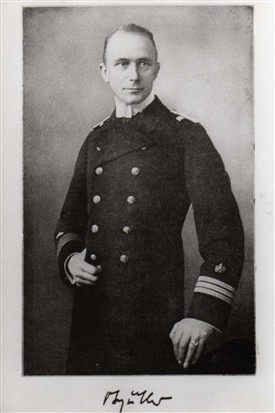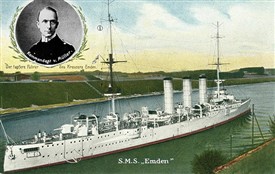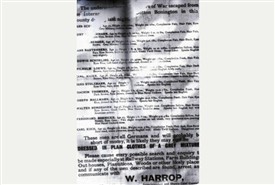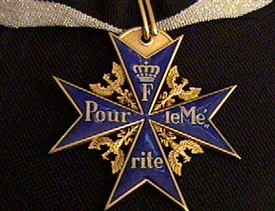VON MüLLER, Karl [of Sutton Bonington]

Karl Friedrich Max von Müller

SMS Emden and her Captain
from an old postcard

Wanted poster listing the escaped German prisoners

The Pour le Mérite
Also known as 'the Blue Max' for obvious reasons

Street in Hanover named after the city's famous naval officer
Famous German escapee
By Ralph Lloyd-Jones
Karl Friedrich Max von Müller was born in 1873 in Hanover, Germany (which had only been united into a single nation since 1871). He joined the Imperial German Navy in 1891 and had reached the rank of Korvettenkapitän (= Commander) by 1908. By 1913 he was captain of the light cruiser SMS Emden with the German East Asia Squadron at their only overseas base, Tsingtao in China.
When the war broke out the supreme commander of German naval forces in the Far East, Count Maximilian von Spee (after whom the famous WW2 ship, Graf Spee, was named) realised that Tsingtao would be quickly captured by Britain’s ally, the Japanese. He therefore had to put the whole Squadron to sea and try to get back to Germany; extremely difficult in the face of worldwide British naval power. Müller made the sensible suggestion that if all the German ships split up and went off in different directions they would be less easy to detect and might cause a lot of mischief to the Allies. The problem was that lacking overseas bases, there was nowhere for them to get fuel (i.e. coal) for their ships. Admiral von Spee, however, gave Müller and his Emden permission to try this surface raiding alone while the rest of the East Asia Squadron made for home.
Müller, his officers and men embarked on one of the most brilliant operations in naval history, immortalising the Emden. The refuelling problem was partly solved by capturing coalers and keeping them near their cruiser to coal up as necessary. They sailed all over the Indian Ocean causing havoc, sinking Allied merchant ships and even bombarding the oil tanks on land outside Madras. They went to remote, undefended Telegraph Island and cut the cable that linked Australasia with the rest of the world. They sank a Russian cruiser in the port of Penang, plus a brave French destroyer which tried to go after them though badly out-gunned. Eventually Emden was cornered in the Keeling Islands by the more powerful Australian cruiser HMAS Sydney and, despite putting up a brave last fight, was crippled and forced to surrender.
The Midland Agricultural and Dairy College at Sutton Bonington had been converted into a Prisoner of War Camp for German officers (and their servants), complete with barbed wire, floodlights and electrified fences. Karl von Müller was interned there and there is some evidence that he may have led the daring breakout of twenty-three prisoners, digging a tunnel under the fence, on the night of 24 September 1917. Certainly he was the highest-ranking, going with other naval and army officers some of whom were aircraft pilots.
Within a week all of the escaped prisoners had been recaptured though a few of them made it to West Bridgford, Trent Bridge and even Chesterfield. It is possible that they were trying to get to goods trains to take them to the coast. They were tried at Derby Assizes, one of the charges against them being ‘theft of blankets belonging to His Majesty King George V’! They had cut the blankets up to make fake civilian clothing. As punishment Karl von Müller had to serve 58 days in Derby Jail before being returned to Sutton Bonington. He was later allowed to go to neutral Holland for medical treatment, since he suffered from malaria contracted in the Far East.
Karl von Müller was promoted to Kapitän zur See (Full Captain) and awarded Germany’s highest Imperial decoration, the Pour le Mérite. Although he returned to Germany after the war his health never really recovered and he died aged 50 in 1923. The site of the POW Camp is now the Sutton Bonington (Agricultural) Campus of Nottingham University.